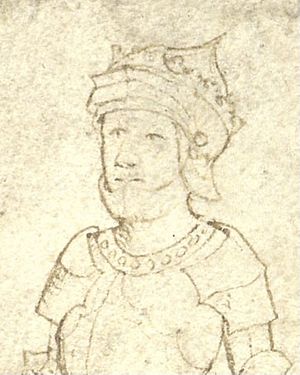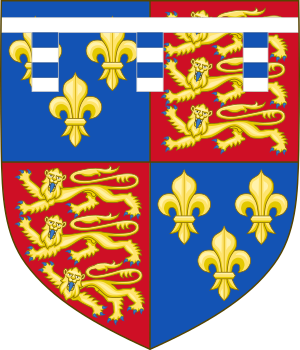Edward Plantagenet, 17th Earl of Warwick facts for kids
Quick facts for kids Edward Plantagenet |
|
|---|---|
| 17th Earl of Warwick | |

A drawing from the "Rous Roll" (1483–1485)
|
|
| Born | 25 February 1475 Warwick, Warwickshire, England |
| Died | 28 November 1499 (aged 24) Tower of London, London, England |
| House | York |
| Father | George Plantagenet, 1st Duke of Clarence |
| Mother | Isabel Neville |
Edward Plantagenet, 17th Earl of Warwick (born 25 February 1475 – died 28 November 1499) was a young English nobleman. He was the son of Isabel Neville and George Plantagenet, 1st Duke of Clarence. Edward was a possible heir to the English throne. This made him a threat to both his uncle, Richard III, and later Henry VII. He was also the younger brother of Margaret Pole, 8th Countess of Salisbury. Edward was put on trial and executed for treason in 1499.
Contents
Edward Plantagenet: A Royal Story
Early Life and Family
Edward Plantagenet was born on 25 February 1475. His parents were George Plantagenet, 1st Duke of Clarence and Isabel Neville. Isabel was the older daughter of a very powerful man, Richard Neville, 16th Earl of Warwick. Edward was born at Warwick Castle, his mother's family home.
When Edward was christened, his uncle, King Edward IV, was his godfather. From birth, he was called the Earl of Warwick. However, he officially received this title after his father died in 1478.
A Young Prisoner
Edward's father was accused of treason and died in 1478. Because of this, some people argued that Edward could not become king. Even so, King Richard III knighted Edward in September 1483.
In 1480, Edward became a "ward" of the King's stepson, Thomas Grey, 1st Marquess of Dorset. Being a ward meant that someone else was in charge of Edward and his money. This guardian could also decide who Edward would marry.
After Richard III became king, Edward was kept in a kind of house arrest. He lived with the King's wife. This was to make sure he could not be used by anyone trying to take the throne.
Why Was He a Threat?
After King Richard III died in 1485, Henry VII became king. Edward was only ten years old, but he was still a possible heir to the throne. This made him a danger to Henry VII's rule. So, Henry VII kept Edward as a prisoner in the Tower of London.
In 1487, a young man named Lambert Simnel pretended to be Edward Plantagenet. This made Henry VII even more worried about Edward. In 1490, Edward's title as Earl of Warwick was officially confirmed. But he remained a prisoner.
His Final Years
Edward stayed in the Tower of London until 1499. At that time, he became involved in a plan to escape with Perkin Warbeck. Warbeck was another person who pretended to be a royal heir. It is not clear if Edward wanted to be part of this plan or if he was forced into it.
The Trial and Execution
On 21 November 1499, Edward was put on trial. He appeared before a group of noblemen at Westminster. A week later, on 28 November 1499, Edward was executed. He was beheaded for treason on Tower Hill, near the Tower of London.
King Henry VII paid for Edward's body and head to be buried. They were taken to Bisham Abbey in Berkshire. The money for this came from Edward's own property.
Many people at the time believed Edward was executed because of pressure from other countries. The rulers of Spain, Ferdinand II of Aragon and Isabella I of Castile, had a daughter named Catherine of Aragon. She was going to marry Henry VII's son, Arthur. Catherine was said to feel very sad about Edward's death. She even thought her own later troubles were a punishment for it.
What Happened After?
Some historians have suggested that Edward might have had a learning disability. This idea comes from a writer named Edward Hall. Hall wrote that Edward's long time in prison made him unable to tell a goose from a capon (a type of chicken). This suggests he might have been confused or isolated.
When Edward died, the main male line of the House of Plantagenet ended. However, other relatives, like the sons of his aunt Elizabeth, Duchess of Suffolk, still claimed the throne.


